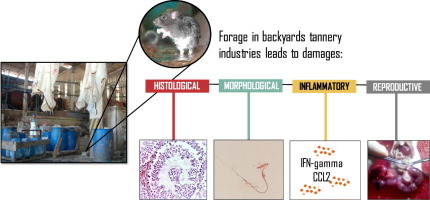Science of the Total Environment ( IF 8.2 ) Pub Date : 2018-08-21 , DOI: 10.1016/j.scitotenv.2018.08.253 Abraão Tiago Batista Guimarães , Raíssa de Oliveira Ferreira , Joyce Moreira de Souza , Dieferson da Costa Estrela , André Talvani , Débora Maria Soares Souza , Thiago Lopes Rocha , Guilherme Malafaia

|
The transformation of skin in-natura into leather in tannery industries generates large volumes of organic matter that attract small mammals. i.e., rodents living close to these facilities. Animals foraging in the backyards of such industries get exposed to the effluent produced by them; however, attention has not been given to the impacts of such exposure on the reproductive biology of these animals. Thus, our study assessed whether the direct exposure to this effluent for periods longer than 90 days leads to reproductive loss in male Swiss mice. We assessed animals' sexual behavior at the end of the experimental period and analyzed their testicular histology, as well as semen quality and volume, besides measuring pro-inflammatory markers and assessing the reproductive performance of the exposed animals. Based on the herein collected data, mice exposed to the gross effluent collected in the backyard of a tannery industry, as well as to the effluent diluted in 5% of water, presented behavioral and histological changes in the testes, disorganized germinal cells in the seminiferous tubules and inflammatory process in intertubular spaces. The inflammatory process resulted from increased proinflammatory cytokine (IFN-gamma and CCL2) concentrations in the testes, fact that explained the larger number of sperm abnormalities and the reduced number of produced sperms. These factors, along with the previously reported changes, may have led to the low reproductive performance of animals exposed to the tested pollutant, which was assessed through the lethal dominant test. This pioneering article addressed the reproductive impact caused by the direct exposure of small rodents to tannery effluents. The research helped better understanding how these pollutants can influence natural ecosystems.
中文翻译:

评价雄性SWISS小鼠制革废水的生殖毒理学
制革业中的天然皮肤向皮革的转化产生了大量吸引小型哺乳动物的有机物质。即,啮齿动物住在这些设施附近。在这类工业的后院觅食的动物会暴露于它们产生的污水中。然而,尚未关注这种接触对生殖生物学的影响这些动物中。因此,我们的研究评估了直接暴露于这种废水超过90天的时间是否会导致雄性瑞士小鼠的生殖损失。我们在实验期结束时评估了动物的性行为,并分析了它们的睾丸组织学以及精液质量和体积,此外还测量了促炎标记并评估了暴露动物的生殖能力。根据此处收集的数据,暴露于制革业后院收集的总废水以及稀释于5%水的废水的小鼠睾丸的行为和组织学变化,生精细胞中杂乱的生殖细胞小管和肾小管间隙的炎症过程。炎性过程是由于睾丸中促炎细胞因子(IFN-γ和CCL2)浓度升高而引起的,这一事实解释了精子异常数量增多和精子产生数量减少的事实。这些因素以及先前报道的变化,可能导致暴露于受测污染物的动物的生殖能力低下,这是通过致死显性试验评估的。这篇开创性的文章探讨了小型啮齿动物直接暴露于制革厂废水中所造成的生殖影响。这项研究有助于更好地了解这些污染物如何影响自然生态系统。这可能导致暴露于受测污染物的动物生殖能力低下,这是通过致死显性试验评估的。这篇开创性的文章探讨了小型啮齿动物直接暴露于制革厂废水中所造成的生殖影响。这项研究有助于更好地了解这些污染物如何影响自然生态系统。这可能导致暴露于受测污染物的动物生殖能力低下,这是通过致死显性试验评估的。这篇开创性的文章探讨了小型啮齿动物直接暴露于制革厂废水中所造成的生殖影响。这项研究有助于更好地了解这些污染物如何影响自然生态系统。











































 京公网安备 11010802027423号
京公网安备 11010802027423号